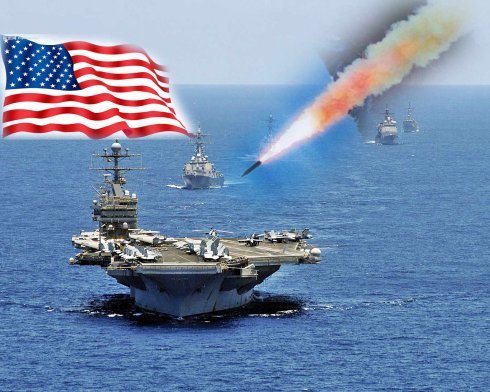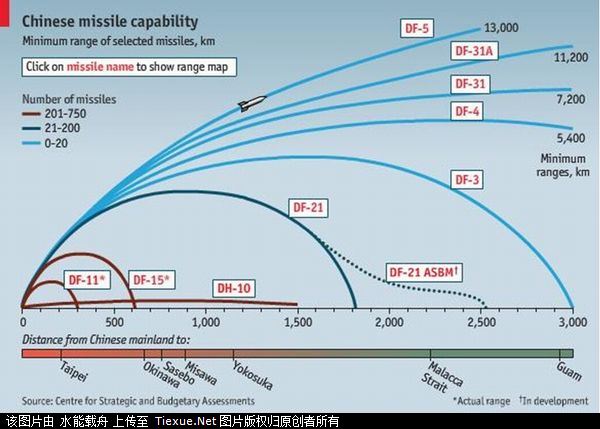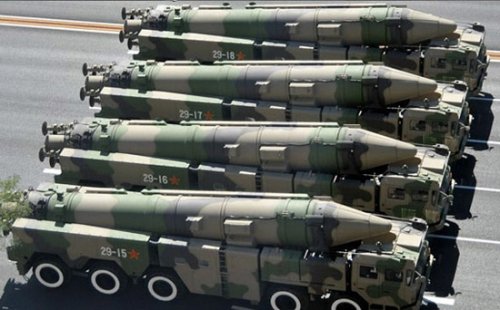|
Hi.Steve
fyi
Since the end of WWII, America's naval might has been undisputed and our aircraft carriers have been its crown jewels. However, the days of dominance could end with China's new DF-21D ballistic missile—the only device on Earth capable of sinking an aircraft carrier—four and a half acres of sovereign US territory—with one shot.
The DF-21D (Dong-Feng 21 variant D) is the world's first and only anti-ship ballistic missile (ASBM). It's a two stage, land-launched missile with a maximum estimated range of 2,700 to 3,000 km. Its single fuel-air explosive warhead packs 200 to 500 kilotons. It was developed by China Changfeng Mechanics and Electronics Technology Academy as part of the country's massive military modernization effort, an initiative focused primarily on developing overwhelming missile technologies for which there are no effective defenses. The Defense Department believes it entered active service around 2009.
While the Chinese obviously aren't saying much on the inner workings of the new missile system, military experts believe it will rely on China's Over the Horizon radar (OTH) to monitor a 3,000-km swath of the South China Sea, where China is now claiming dominion over. The OTH system bounces its radar signal off the ionosphere to see past the curvature of the earth. If the OTH detects a carrier battle fleet, the system instigates a set of Yaogan satellites to search the area and provide precise targeting data. Additionally, when the OTH detects an approaching fleet, the system will reportedly launch a swarm of micro-satellites into low orbit where they will help refine the targeting data further and transmit it back to the onshore command center. Meanwhile, UAVs will be launched to track the fleet. Once the missile has been launched and separated from its first stage, the warhead employs synthetic aperture radar to find the carrier. It receives real time telemetry data as it locks onto its target and initiates its terminal descent.
This capability could be used to effectively deny US carriers from intervening in, say, the Taiwan Strait. It could also be used as a very large stick in resolving local territorial disputes. Many members of the security community also worry that the FAE warheads could easily be replaced with nuclear ones. If that occurred, it would very lead to an arms race with Japan and India (neither of whom are particularly fond of the Communist PRC). Or, it could dissolve the US-Russian INF Treaty, which prevents the two countries from from deploying short and intermediate range land-based ballistic and cruise missiles.
U.S. naval planners are scrambling to deal with what analysts say is a game-changing weapon being developed by China — an unprecedented carrier-killing missile called the Dong Feng 21D that could be launched from land with enough accuracy to penetrate the defenses of even the most advanced moving aircraft carrier at a distance of more than 1,500 kilometers (900 miles).
Analysts say final testing of the missile could come as soon as the end of this year, though questions remain about how fast China will be able to perfect its accuracy to the level needed to threaten a moving carrier at sea.
The weapon, a version of which was displayed last year in a Chinese military parade, could revolutionize China's role in the Pacific balance of power, seriously weakening Washington's ability to intervene in any potential conflict over Taiwan or North Korea. It could also deny U.S. ships safe access to international waters near China's 11,200-mile (18,000-kilometer) -long coastline.
While a nuclear bomb could theoretically sink a carrier, assuming its user was willing to raise the stakes to atomic levels, the conventionally-armed Dong Feng 21D's uniqueness is in its ability to hit a powerfully defended moving target with pin-point precision.
Funded by annual double-digit increases in the defense budget for almost every year of the past two decades, the Chinese navy has become Asia's largest and has expanded beyond its traditional mission of retaking Taiwan to push its sphere of influence deeper into the Pacific and protect vital maritime trade routes.
"The Navy has long had to fear carrier-killing capabilities," said Patrick Cronin, senior director of the Asia-Pacific Security Program at the nonpartisan, Washington-based Center for a New American Security. "The emerging Chinese antiship missile capability, and in particular the DF 21D, represents the first post-Cold War capability that is both potentially capable of stopping our naval power projection and deliberately designed for that purpose."
Setting the stage for a possible conflict, Beijing has grown increasingly vocal in its demands for the U.S. to stay away from the wide swaths of ocean — covering much of the Yellow, East and South China seas — where it claims exclusivity.
It strongly opposed plans to hold U.S.-South Korean war games in the Yellow Sea off the northeastern Chinese coast, saying the participation of the USS George Washington supercarrier, with its 1,092-foot (333-meter) flight deck and 6,250 personnel, would be a provocation because it put Beijing within striking range of U.S. F-18 warplanes.
The carrier instead took part in maneuvers held farther away in the Sea of Japan.U.S. officials deny Chinese pressure kept it away, and say they will not be told by Beijing where they can operate.
But the new missile, if able to evade the defenses of a carrier and of the vessels sailing with it, could undermine that policy.
"China can reach out and hit the U.S. well before the U.S. can get close enough to the mainland to hit back," said Toshi Yoshihara, an associate professor at the U.S. Naval War College. He said U.S. ships have only twice been that vulnerable — against Japan in World War II and against Soviet bombers in the Cold War.
Carrier-killing missiles "could have an enduring psychological effect on U.S. policymakers. "It underscores more broadly that the U.S. Navy no longer rules the waves as it has since the end of World War II. The stark reality is that sea control cannot be taken for granted anymore."
Yoshihara said the weapon is causing considerable consternation in Washington, though — with attention focused on land wars in Afghanistan and Iraq — its implications haven't been widely discussed in public.
Analysts note that while much has been made of China's efforts to ready a carrier fleet of its own, it would likely take decades to catch U.S. carrier crews' level of expertise, training and experience.
But Beijing does not need to match the U.S. carrier for carrier. The Dong Feng 21D, smarter, and vastly cheaper, could successfully attack a U.S. carrier, or at least deter it from getting too close.
U.S. Defense Secretary Robert Gates warned of the threat in a speech last September at the Air Force Association Convention.
"When considering the military-modernization programs of countries like China, we should be concerned less with their potential ability to challenge the U.S. symmetrically — fighter to fighter or ship to ship — and more with their ability to disrupt our freedom of movement and narrow our strategic options," he said.
Gates said China's investments in cyber and anti-satellite warfare, anti-air and anti-ship weaponry, along with ballistic missiles, "could threaten America's primary way to project power" through its forward air bases and carrier strike groups.
The Pentagon has been worried for years about China getting an anti-ship ballistic missile. The Pentagon considers such a missile an "anti-access," weapon, meaning that it could deny others access to certain areas.
|


 字體:小 中 大
字體:小 中 大











